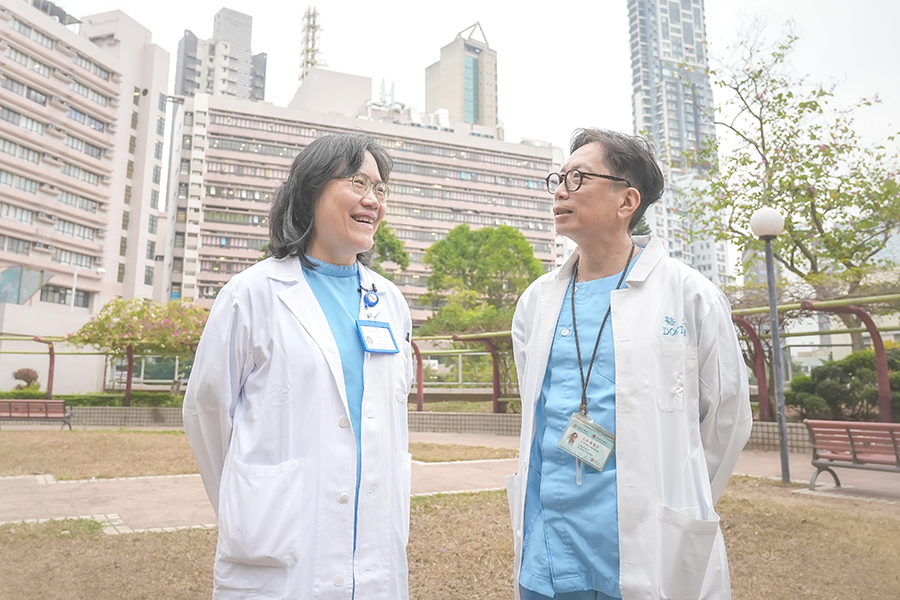
Hospitals grow side by side to serve the community
 Wan Chai is home to two hospitals with very different backgrounds – Ruttonjee Hospital (RH) and Tang Shiu Kin Hospital (TSKH) – which have worked together and integrated services over the years for the benefit of the residents of Hong Kong Island East.
Wan Chai is home to two hospitals with very different backgrounds – Ruttonjee Hospital (RH) and Tang Shiu Kin Hospital (TSKH) – which have worked together and integrated services over the years for the benefit of the residents of Hong Kong Island East.
In the 1940s, tuberculosis was rampant in Hong Kong. Philanthropist Jehangir Hormusjee Ruttonjee, CBE, JP, has generously donated to the Hong Kong Anti-Tuberculosis Association (renamed as “Hong Kong Tuberculosis, Chest and Heart Diseases Association” after 1980) to convert the formerly Royal Naval Hospital into Ruttonjee Sanatorium in 1949 to take care of the tuberculosis patients. With the declining number of cases, it was converted into Ruttonjee Hospital in 1991 to meet with service need. Tang Shiu Kin Hospital was opened in 1969 and named after the late Sir Tang Shiu-kin for his generous donation. It served as the leading acute hospital for Eastern District until Pamela Youde Nethersole Eastern Hospital opened in 1993.
To enhance efficiency, the services of the two hospitals were then merged with the Accident and Emergency (A&E) Department and some specialist outpatient clinics transferred to RH in 2002, while TSKH was developed into a community ambulatory care centre where selected healthcare services co-located with social services.
A&E Advanced Practice Nurse of RTSKH Lee Chi-ho, who has been a nurse for nearly 40 years, recalls how challenging it was due to the limited facilities at the A&E Department at TSKH in the early years. “We were responsible for receiving serious cases in the Eastern District but many specialties were not available, so additional procedures had to be done in the A&E department to stabilise the patient’s condition before arranging for a transfer to another hospital,” he says. “For example, if a patient had a pneumothorax, the chest drain would be done by a specialist in a leading hospital. But in the A&E at TSKH, we had to put in a chest tube ourselves before transferring the patient, which was very challenging.”
 Chi-ho had dealt with a number of major incidents over the years, including the Lan Kwai Fong tragedy when 21 people were killed on the New Year Eve of 1992, the North Point lift accident that claimed the life of 12 construction workers in 1993, and the Lamma Island ferry crash with 39 killed in 2012. “I particularly remember the clashes between police and Korean farmers protesting at the World Trade Organisation Ministerial Conference in Hong Kong in 2005. That night, the A&E department was fully mobilised. Most patients needed stitches. Medical staff put themselves at risk by returning to the department in the middle of the night, from the head of the hospital to colleagues of all ranks,” he remarks.
Chi-ho had dealt with a number of major incidents over the years, including the Lan Kwai Fong tragedy when 21 people were killed on the New Year Eve of 1992, the North Point lift accident that claimed the life of 12 construction workers in 1993, and the Lamma Island ferry crash with 39 killed in 2012. “I particularly remember the clashes between police and Korean farmers protesting at the World Trade Organisation Ministerial Conference in Hong Kong in 2005. That night, the A&E department was fully mobilised. Most patients needed stitches. Medical staff put themselves at risk by returning to the department in the middle of the night, from the head of the hospital to colleagues of all ranks,” he remarks.
Deputy Hospital Chief Executive of RTSKH, Dr Jenny Leung, has been working in the Department of Medicine and Geriatrics since graduation. She witnessed the evolution of the hospital over the three decades. “The hospital started from dealing mainly with tuberculosis patients, to adding specialties such as geriatrics, medicine, surgery, orthopaedics and traumatology, intensive care unit, etc. Nowadays, the average age of patients is getting higher, and cases are far more complicated, so it is necessary to bring together different teams to formulate personalised treatment plans. As the demand for healthcare services increases, I look forward to the expansion of various kinds of hospital services to serve more people in need.”
Department of Medicine and Geriatrics Associate Consultant Dr Wong Che-keung is a long-time work partner of Dr Leung and treasures the relationship that has grown between the hospital and the community. “My patients have come to the hospital for geriatric services from middle age to old age and some of their children now come to the Geriatric Day Hospital. They have a sense of belonging here.” He adds that RH has also pioneered geriatric services. The concept of the Patient Support Call Centre to enhance support for elderly people at risk of hospitalisation and patients with chronic diseases originated from RH’s Community Geriatric Assessment Team. “As time goes by, there is a clearer division of service scope between RH and TSKH, but what remains unchanged is the care for the patients,” Dr Wong points out. “I sincerely believe that the bond of trust between doctors and patients can be sustained.”
